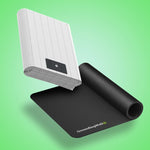
Grounding mats are designed to help your body reconnect with the Earth’s natural energy, but many people wonder whether direct skin contact is required. At GroundingWell, we focus on making grounding simple, practical, and accessible, so understanding how grounding mats work and how to use them correctly can ensure you receive the strongest and most consistent benefits.
Table of Contents
- Key Takeaways
- Why Bare Skin Contact Improves Grounding?
- 1. How Grounding Mats Work
- 2. The Case for Being Barefoot
- 3. Can You Use a Grounding Mat With Socks or Shoes?
- 4. Grounding Mats During Sleep
- 5. Grounding Mats for Office or Desk Use
- 6. Alternative Ways to Ground Without Being Barefoot
- 7. Safety and Practical Considerations
- How Long Should You Ground Each Day?
- How Different Materials Affect Grounding
- Conclusion
- FAQs:
Key Takeaways
- Bare skin contact creates the strongest grounding connection
- Thin socks or lightweight clothing may still allow conductivity
- Grounding mats can be used in multiple areas of the home
- Consistency matters more than timing or technique
- GroundingWell mats offer safe, reliable indoor grounding options
Why Bare Skin Contact Improves Grounding?
Grounding is based on electron exchange. Your skin acts as a natural conductor, meaning electrons can travel freely through the grounding mat into your body without resistance.
Direct skin contact may help support:
- Nervous system regulation
- Reduced morning tension
- More stable sleep cycles
- Calmer stress responses
Studies published in resources suggest grounding may enhance heart rate variability, a key marker for nervous system balance. Grounding mats connect your body to the Earth’s natural energy, which is believed to help neutralize free radicals, improve sleep, and decrease inflammation. A common question that arises when using a grounding mat is: Do you need to be barefoot to experience the benefits? The answer involves understanding how grounding mats work, the role of direct skin contact, and alternative ways to use them effectively.
1. How Grounding Mats Work
Grounding mats are designed with conductive materials, such as silver or carbon fibers, that allow electrons from the Earth to flow into your body. These mats are typically connected to a grounded wall outlet or a grounding rod placed in the soil.
The process works like this:
- The mat connects to the Earth’s electrical field.
- Electrons move through the conductive material into the body.
- These electrons help neutralize positive charges in the body, which may reduce inflammation and oxidative stress.
- The result is a subtle calming effect, improved sleep, and an overall sense of balance.
Because electrons need a pathway to enter the body efficiently, direct skin contact is usually recommended. This is why the barefoot question comes up frequently.
2. The Case for Being Barefoot
Direct skin contact with a grounding mat, most commonly by being barefoot, is considered the most effective way to experience grounding benefits.
Reasons barefoot contact is ideal include:
- Minimal Resistance: Shoes, socks, and most fabrics create a barrier that reduces the flow of electrons.
- Full-Body Grounding Potential: When your bare feet are in direct contact, your entire body can maintain electrical balance more easily.
- Increased Circulation: Barefoot contact can stimulate blood flow and improve overall relaxation.
For those looking to maximize the benefits, using a grounding mat barefoot while standing, sitting, or lying down is generally recommended.
3. Can You Use a Grounding Mat With Socks or Shoes?
While being barefoot is ideal, it is still possible to use a grounding mat with socks or shoes, though the effectiveness may be reduced.
Considerations when wearing socks or shoes:
- Material Matters: Cotton or thin natural fiber socks allow some conductivity, while thick, rubber-soled shoes block most electron flow.
- Partial Benefits: You may still receive some grounding benefits if a portion of your body touches the mat directly, such as your hands or forearms.
- Practical Solutions: If you prefer to keep socks on, you can roll them down or place your hands directly on the mat to improve conductivity.
Overall, socks or shoes do not prevent grounding entirely, but they limit the intensity and effectiveness.
4. Grounding Mats During Sleep
One of the most common uses of grounding mats is while sleeping. Many people wonder if being barefoot is necessary when lying on a bed.
Tips for grounding during sleep:
- Place the mat under your bedsheet or mattress pad where your feet or hands can make direct skin contact.
- If you sleep with socks on, ensure that at least part of your feet, hands, or arms touch the mat.
- Full-body mats allow for more consistent grounding, even if some parts of the body are covered by blankets.
Being barefoot during sleep isn’t mandatory, but skin-to-mat contact maximizes potential benefits, especially for reducing stress and improving sleep quality.
5. Grounding Mats for Office or Desk Use
Many people use grounding mats while working at a desk. In this case, barefoot use is highly recommended, especially if the mat is placed under your feet.
Desk grounding tips:
- Place the mat under your chair where your bare feet can rest directly.
- If barefoot isn’t an option, ensure your hands or forearms contact the mat while typing or resting.
- For added benefit, take breaks to stand barefoot on the mat for a few minutes.
Even brief barefoot contact at your desk can support circulation, reduce stress, and improve energy levels.
6. Alternative Ways to Ground Without Being Barefoot
If being barefoot isn’t practical, there are several alternative ways to maintain a grounding connection:
Alternatives include:
- Direct Hand Contact: Place your palms on the mat while working, reading, or meditating.
- Use a Grounding Sheet on the Bed: Lie on the sheet so your arms, legs, or feet touch the conductive surface.
- Wear Conductive Socks or Gloves: Some products include silver or carbon fibers that allow electrons to pass through the material.
- Combine Mats and Body Contact Points: Use mats for feet while also placing your hands on another grounded surface for added effect.
While these alternatives may be slightly less effective than barefoot contact, they still provide meaningful grounding benefits.
7. Safety and Practical Considerations
Using a grounding mat is generally safe, but there are a few things to keep in mind:
Safety tips:
- Ensure the mat is properly connected to a grounded outlet or rod.
- Avoid using the mat with damaged cords or faulty outlets.
- Keep mats dry and clean, especially if barefoot contact is frequent.
- People with pacemakers or other electronic implants should consult their doctor before using grounding products.
Proper setup ensures safe and effective use, whether barefoot or with alternative contact methods.
How Long Should You Ground Each Day?
Most individuals start with 20–30 minutes, but the duration of grounding mats can easily extend to several hours as grounding becomes part of your daily routine. Many people use their mats throughout the workday or during evening rest for a steady, comfortable connection.
Barefoot grounding typically accelerates results, but consistency is the most important factor, not duration alone.
You may notice:
- Deeper rest
- Reduced tension
- Improved clarity
- Calmer mood
Overnight grounding with sheets or mats may help you sustain these benefits more easily.
How Different Materials Affect Grounding
Certain clothing materials conduct better than others.
Strong conductivity:
- Bare skin
- Thin cotton socks
- Lightweight natural fabrics
Weak conductivity:
- Thick wool
- Heavy synthetic fibers
- Rubber-soled footwear
If you are using your grounding mat while working, meditating, or relaxing, try positioning your feet or hands directly on the surface.
Conclusion
Bare skin contact provides the strongest grounding experience, but grounding mats still work through thin socks or light clothing. The key is consistency and comfort, choosing methods that fit naturally into your daily routine. At GroundingWell, our goal is to help you ground easily at home, at work, or during rest. For guidance on choosing the right grounding products or improving your routine, contact us today for personal support.
FAQs:
Do grounding mats work through socks?
Yes. Thin socks allow some conductivity, though bare skin provides a stronger connection.
Can I use a grounding mat while working?
Absolutely. Many people place grounding mats under their desks to stay grounded for several hours a day.
How long should I use the grounding mat each day?
Start with 20–30 minutes, then increase based on comfort and routine.
Is it safe to use grounding mats indoors?
Yes. Grounding mats connect only to the grounding port, not electrical current.
Do grounding mats help with stress?
Research suggests grounding may support stress reduction by helping balance the autonomic nervous system.
What part of the body should touch the grounding mat?
Feet, hands, or legs offer the best and most consistent grounding contact.








